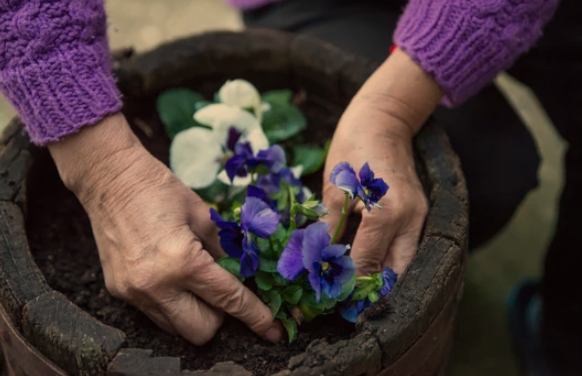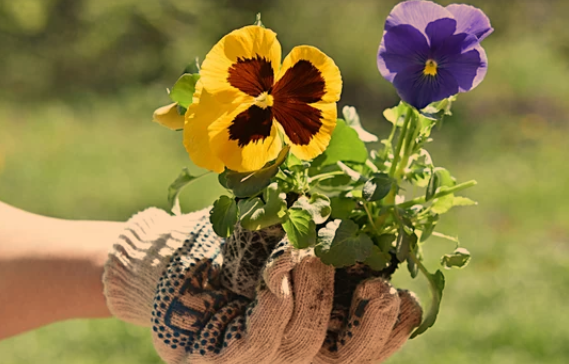When To Start Pansy Seeds For Fall Display?
As the warmth of summer gives way to the crisp embrace of autumn, garden enthusiasts eagerly anticipate the chance to breathe new life into their outdoor spaces.
Pansies, with their delicate beauty and vibrant colors, offer a perfect opportunity to infuse the fall landscape with a burst of charm.
However, achieving this seasonal transformation requires more than just enthusiasm it demands strategic planning and impeccable timing when it comes to sowing pansy seeds.
So ticks around, we unravel the precise art of timing and share professional insights on when and how to sow pansy seeds for an awe-inspiring fall showcase.
The Seasonal Symphony of Pansies

Pansies (Viola × wittrockiana) are the virtuosos of the Fall Garden orchestra. Their versatility, captivating colors, and remarkable adaptability to cooler temperatures make them an ideal choice for fall landscapes. As the lush vibrancy of summer wanes, pansies step onto the stage to fill the void, creating a tapestry of hues that celebrates the autumn season in all its splendor.
When To Start Pansy Seeds?

When To Start Pansy Seeds For Fall Display
Sowing pansy seeds for a stunning fall display requires careful consideration of your local climate and frost dates. Generally, you’ll want to start pansy seeds indoors well in advance to ensure they are ready for transplanting outdoors when the temperatures cool down. Here’s a general guideline to help you determine when to start pansy seeds for a fall display:
Calculate the First Frost Date:
Find out the average date of the first expected frost in your area. This information is crucial for determining when you should start your pansy seeds. You can usually find this information from local gardening resources, extension offices, or online weather databases.
Count Backwards:
Pansies typically require 6 to 10 weeks to grow from seeds to transplant-ready seedlings. Count backward from the first frost date to determine the optimal seed starting date. For instance, if your average first frost date is around early October, you might want to start your seeds indoors around mid-July to early August.
Consider Germination Time:
Pansy seeds usually take about 7 to 14 days to germinate. When counting backwards, be sure to account for this germination period as well. If you’re aiming to transplant mature seedlings around early October, you might need to start your seeds by late June to early July to allow for germination and growth.
Local Climate Variations:
Keep in mind that regional climate variations, microclimates, and specific weather patterns can affect the accuracy of frost date predictions. If you’re uncertain, it’s always wise to consult local gardening experts, extension offices, or experienced gardeners in your area for tailored advice.
Adjust for Your Location:
If you live in a warmer climate with milder fall temperatures, you might be able to adjust your planting timeline accordingly. In such cases, you may start your seeds a bit later than the general guidelines suggest. Conversely, if your fall temperatures tend to arrive early, you should start your seeds earlier.
Calculating the Seed Starting Date
A virtuoso gardener understands that the growth cycle of pansies spans 6 to 10 weeks from seed to transplant size. Germination, a vital step in the process, requires 7 to 14 days. Armed with this knowledge, the next step is to calculate the optimal seed starting date. Working backward from the first frost date, one factor in the germination period is to ensure that the pansies reach their crescendo precisely when the fall landscape beckons for their brilliance.
Strategic Execution: The Seed Starting Process
Pansy cultivation begins with the careful selection of seeds. Choose seeds sourced from reputable suppliers, ensuring a diverse assortment of colors and patterns to enrich the fall ensemble. Sowing these treasures requires the right vessels shallow trays or dedicated seed-starting trays with proper drainage. Employing a sterilized, well-draining seed-starting mix, the gardener sets the stage for healthy growth and development.
How to Sow Pansy Seeds
Sowing pansy seeds is a delicate art. Gently scatter the seeds over the prepared growing medium, ensuring even distribution. With a deft touch, press the seeds lightly into the soil, securing a harmonious connection that promises robust growth. A touch of vermiculite or seed-starting mix acts as the curtain that delicately veils the stage, fostering the ideal conditions for moisture retention.
Optimal Germination Conditions
The seeds are sown, and the curtain rises on the germination phase. Place the trays in well-lit areas with filtered sunlight an environment that mirrors the pansies’ preference for cool yet bright surroundings. Maintaining a consistent temperature between 70 to 75°F (21 to 24°C) is paramount. Just as a musician tunes their instrument, the gardener’s misting technique fine-tunes moisture levels, striking the perfect chord for germination success.
Transplanting Pansy Seeds

When To Start Pansy Seeds
As the seedlings grow, their journey necessitates a transition to larger accommodations. This delicate transfer is a crucial act in the symphony of pansy cultivation. With the emergence of true leaves, seedlings are carefully transplanted into individual pots or trays. Yet, the performance is not over. Gradual acclimatization to the outdoor environment must occur, readying the young pansies for their grand debut in the fall landscape.
Best Practices for Sowing Pansy Seeds

- Seed Selection: Choose high-quality pansy seeds from reputable suppliers. Opt for a mix of colors and patterns that complement your desired fall aesthetic.
- Container Selection: Use shallow trays or seed-starting trays with good drainage. Ensure the chosen containers are clean and sterilized to prevent disease.
- Growing Medium: Select a well-draining, sterile seed-starting mix to provide the best conditions for germination.
- Sowing Seeds: Scatter the pansy seeds evenly over the surface of the growing medium. Press the seeds lightly into the soil, ensuring they are in good contact while still being visible.
- Cover and Mist: Sprinkle a thin layer of fine vermiculite or seed-starting mix over the seeds to help retain moisture. Mist the surface gently to avoid disturbing the seeds.
- Provide Ideal Conditions: Place the trays in a well-lit area with indirect sunlight. Maintain a consistent temperature within the recommended range for germination.
- Moisture Management: Keep the growing medium consistently moist but not waterlogged. Using a spray bottle can help you control moisture levels effectively.
- Transplanting: Once seedlings have developed a few true leaves, they can be transplanted into individual pots or trays for further growth before planting outdoors.
Mastering the timeline of pansy cultivation demands precision and dedication. Knowing the secrets of timing, seed starting, and germination conditions, gardeners can orchestrate a breathtaking fall display that captivates the senses. As the autumn breeze carries the promise of change, the symphony of pansies unfolds, proving that with the right knowledge and care, a resplendent fall landscape is within reach for those willing to embrace the artistry of nature.



